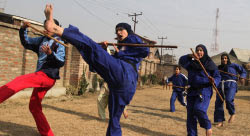The recent years have seen a sea change in societal attitudes and sexual norms. The taboos have been left behind and sexual
 mores are more liberal. To wait for sex till marriage seems to be a thing of the past. Sex is not difficult to get...it is easily available and abundant. Not only men, women also want fulfilment. Condoms and birth control pills have found their way into school bags. The bedroom is a laboratory for experimentation. And this is not just limited to the metros. The heat is being turned on in small towns and villages, traditionally considered the bastions of morality. The society seems to be embracing this change.
mores are more liberal. To wait for sex till marriage seems to be a thing of the past. Sex is not difficult to get...it is easily available and abundant. Not only men, women also want fulfilment. Condoms and birth control pills have found their way into school bags. The bedroom is a laboratory for experimentation. And this is not just limited to the metros. The heat is being turned on in small towns and villages, traditionally considered the bastions of morality. The society seems to be embracing this change.This, however is just one side of the picture. The other side is quite the opposite. Sexual longevity is on the wane. While sexual openness is on the rise, the dream of a long sexual life is proving to be just that – a dream. Earlier the ardour would start waning at 40, now the drop starts at the age of 30. Earlier the sexual prowess of men at the age of 60 would also be a given, work stress and a hectic life mean more and more men are putting sex on the back burner. Matters become worse when both partners have jobs.
Daily life caught in the rut of shifts, the pressures of performance appraisals, mental stresses caused by financial insecurities, shrinking social spaces and inequalities in close relationships are taking their toll in the bedroom. Take the case of Amit and Gauri. They are media professionals married for two years. Amit has been on the morning shift in his news channel for the last three months. Gauri gets free from her newspaper shift around 1.00 am. By the time she gets home, Amit is in deep sleep. When Amit leaves, Gauri is catching up on sleep. “If we ever make love it is hurried and awkward. It seems I will have to take leave from work to enjoy sex,” rues Gauri.
Suresh Majumdar, former clinical psychologist of the Ahmedabad based DM Institute of Mental Health says, “Hectic schedules are the death knell of life. Mobiles and computers have changed lives completely. While they have made our life easy, they have also increased the pressures. People work for 17-18 hours and often carry work home. People get up and get right to work. They have no time for themselves and are tired both mentally and physically. Tolerance levels are falling, people are easily irritable. All this impacts one’s sex life. Often people seek help in alcohol but this only compounds the problem,” he says.
Sexual initiation starts at a younger age. The easy availability of porn means children are sexually hyper active. This early start also means a premature death to one’s sexual life. Dr Amresh Kumar Singh of the Devraj Ars Medical College, Kolar, says, “If you are not suffering from any sexual abnormality, there is no age limit to which you can enjoy sex although individuals differ in their limits and abilities. When sexual initiation happens at a young age, sexual desires begin to wane early. Priorities also change with age.”
A healthy sexual life demands a fit body and a peaceful mind. Dr KK Agarwal of the Heart Care Foundation, New Delhi, lays the blame for waning sexual desire on lifestyle related diseases. “A careless attitude towards oneself can have disastrous consequences. A love for the easy life is making the road ahead difficult. Increasingly diabetes and heart diseases are taking hold of younger people. All this affects one’s sexual life.”
After a long career in a nationalised bank, Srawan Verma opted for voluntary retirement and now lives at Noida where he helps his son in his business. “The period between the ages of 30 and 40 is marked by an inability to accept the days of one’s youth are a thing of the past. The body refuses to comply with the mind. The tuning goes off key and sexual life bears the brunt of this.”
Rajkishore Prasad, an HR professional in an MNC, disagrees. “The body listens to the mind when it comes to sex. If your personality is colourful you will enjoy sex all your life. Mental preparation is a must to enjoy sex. But what happens is that sex just becomes a chore. The pleasure is thrown out of the equation.”
GK Thakur, a 43-year-old academician living in Greater Noida reasons, “The problem lies with those who consider sex a mechanical process whereas it is the emotional content which ranks higher. Emotions and feelings cannot be overlooked. These are like foreplay to the
actual act, much like appetisers before the actual meal. Not only do they pique the hunger, they make its fulfilment more satisfying. Every below par performance in the bedroom punches a hole in the male ego. This can eat away into one’s sex life.”
Is there a way out? Vishal Chabbra, consultant psychiatrist at the Vimhans Hospital says, “One needs to be physically and mentally fit to enjoy sex. Try to find time for yourself in the daily business of living. Keep your weekends for yourself and enjoy them fully. This will keep you energised and fresh. Find time for your hobbies. Social interactions and activities are extremely important. As far as preparing yourself for sex is concerned, change the atmosphere in the bedroom. Use fragrances of your choice. Try new positions and techniques. Be experimental. This will bring change. Sexual desire is like a perpetual flame. It doesn’t die out though it may decrease in intensity.” To keep the flame burning is a key ingredient of a happy and fulfilling life.
For More IIPM Info, Visit below mentioned IIPM articles.
IIPM ranks No 1 in International Exposure in the 'Third Mail Today B-School Survey'
Management Guru Arindam Chaudhuri Dean Business School IIPM
IIPM Excom Prof Rajita Chaudhuri
Kapil Sibal’s voters want Jan Lokpal, not Government-proposed Lokpal Bill
IIPM: What is E-PAT?
IIPM RANKED NO.1 in MAIL TODAY B-SCHOOL RANKINGS
'Thorns to Competition' - You can order your copy online from here
IIPM Mumbai Campus




